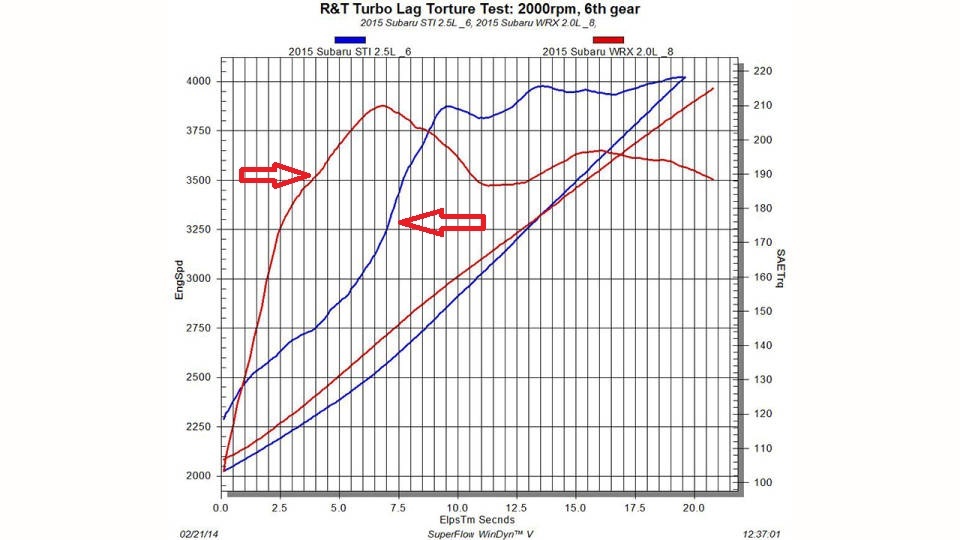
Short answer: yes and no.
Full explanation:
For example a manufacturer states the engine puts out 268hp@5600rpm, and 258 lb-ft of torque@2000rpm, it only means: when the engine is revving at 5600rpm, the maximum power it can deliver is 268hp; when the engine is revving at 2000rpm, the maximum torque it will deliver is 258 lb-ft.
But it does not tell you WHEN it can attain such value. Take the above engine for example: 258 lb-ft of torque at 2000rpm – it does not mean every time when you see your tachometer needle points at the 2000rpm mark, the engine is outputting 258 lb-ft of torque.
The first factor is how deep you are pressing the gas pedal (which shows how eagerly you want to accelerate);
The second factor is trickier for nowadays turbo engine. For turbo engine, it cannot deliver the stated maximum torque and horsepower unless its turbine blades are rotating at the maximum designed speed, providing the suitable air compression/boost ratio. For the above example, 258 lb-ft of torque at 2000rpm means: if the engine is revving at 2000rpm AND its turbo’s rotating has risen to the designed maximum rotating speed, providing the maximum boost, then this 258 lb-ft of torque will be guarantee.
Since when the engine is idling or under light load, the turbo will not kick in (means at those cases the turbo’s turbine blades are stopped and not rotating), this leaves us a question: how soon the turbo can speed up the rotating and provide the maximum boost? This depends on how well the turbo engine is designed and this involves a lot of technologies. The term “turbo lag” is referring to what we are talking right now. The smaller the turbo lag, the sooner the turbo can speed up the rotating to provide full boost. So higher torque at the same engine speed does not mean superior performance, it’s the time that how soon it can reach this torque matters.
Generally speaking even for some of the modern turbo engines, it still takes a certain amount of time to attain the full boost pressure. Here is a turbo lag test done by Road and Track, which compares the 2015 Subaru WRX and 2015 Subaru WRX STI.
2015 Subaru WRX engine output is 268hp@5600rpm, and 258 lb-ft of torque@2000-5200rpm
2015 Subaru WRX STI engine output is 305hp@6000rpm, and 290 lb-ft of torque @ 4000rpm
By just looking at the numbers, it appears that the STI should be the clear win. But further tests show more interesting facts.
Oddly enough, even though they are the same model year, the Subaru WRX is using a newer design of turbo engine (FA20DIT); while the WRX STI is using an older design engine (EJ257). These engines are completely different than each other. Turbo lag test shows the WRX STI has significantly larger tubo lag, please see the following figure:
We can see even the STI engine has higher stated torque, when the engine starts to rev up, between 0 and 7.7 seconds the WRX engine actually has much higher torque output than the STI!
When the WRX is making full torque, the STI is still 45 lb-ft behind it. It’s not until 7.7 seconds that the STI starts to display its higher output ability. We admit: in daily driving, you can do lots of things within 7.7 seconds.
From Road and Track’s test of rolling start (which will set the car to accelerate when its engine is idling) to 60mph, the lower powered WRX is quicker than the high output STI (7.0 vs 7.1 seconds). The above analysis explains why. From the above figure we also discover: even for the WRX, it still takes around 7 seconds to let the turbo to attain maximum boost, which is exactly the “turbo-lag”.
When you are shopping for a new car, if two turbo engine cars both states similar hp/torque outputs at similar engine speed, this does not mean they will has the same accelerate performance. You need to go and test drive them before making any purchase decisions, because the turbo lag really matters.




Recent Comments